|
|
Post by zaku on Mar 9, 2020 5:29:12 GMT -5
Thank you for your thoughtful reviews! It's interesting what was the golden rule of time travel in Superman's books: it's physically impossibile to change the past. Stop. From a narrative point of view it makes sense, since Pre-Crisis Superman could travel through time as easily as I take a walk and it is an important plot point in Crisis too. The rule was confined to Superman's books and it wasn't mentioned in others' (like other characters who sometimes time-traveled like Atom or Flash). Did they mention this in the story?  |
|
|
|
Post by dbutler69 on Mar 9, 2020 7:58:10 GMT -5
Oh yeah, I definitely remember Frogger. I suppose it's embarrassing by today's video game standards, but I don't care, I enjoyed that one back in the day.
I actually like the Per Degaton stories I've read but yeah, he's getting a bit overused by this point.
|
|
|
|
Post by Hoosier X on Mar 9, 2020 11:01:04 GMT -5
I was not such a big fan of the JLA at this point, but I was reading All-Star Squadron and I love the JSA, so I read the multi-part JSA-JLA-All-Star Squadron cross-over when it first came out, and it remains one of my favorites of the annual JSA-JLA cross-overs, even all these years later when I’ve read a lot more JLA and all the JLA/cross-overs. (Maybe I prefer the SSOSV x-over a tad. And the one with the Seven Soldiers and also the one with the Freedom Fighters, these are also contenders.)
I wrote a short story that takes place during the Cuban Missile Crisis, and I did a lot of research that included numerous pop culture trivia of the time period, and my favorite bit of gratuitous October 1962 information is that the Monster Mash was becoming a hit and getting a lot of airplay during the whole Crisis. Well, it was Halloween season!
|
|
|
|
Post by codystarbuck on Mar 12, 2020 16:28:17 GMT -5
Justice League of America #208 I've always felt that the face in the mushroom cloud looked like the Joker, even though it's obviously Per degaton. I'm curious to know what is on the other end of Liberty belle and Firebrand's ropes, as they seem to be over water. Did they swing down from the rigging, like Burt Lancaster? George should have had them being towed by one of the flyers. Creative Team: Gerry Conway-writer, Don Heck-pencils, Sal Trapani-inks, Phil Felix-letters, Carl Gafford-colors, Len Wein editor, Roy Thomas-plot consultant Synopsis: We are back to the JLA POV of the ASS walking into the JSA MR. (This comic brought to you by Alpha-bits, the cereal that lets you spell out how buzzed you are from the sugar!) This being a comic written by Gerry Conway, instead of rational, calm attempts to discern who everyone is, they, instead, start swinging. This carries on until Superman yells "You kids knock off all that racquet!" 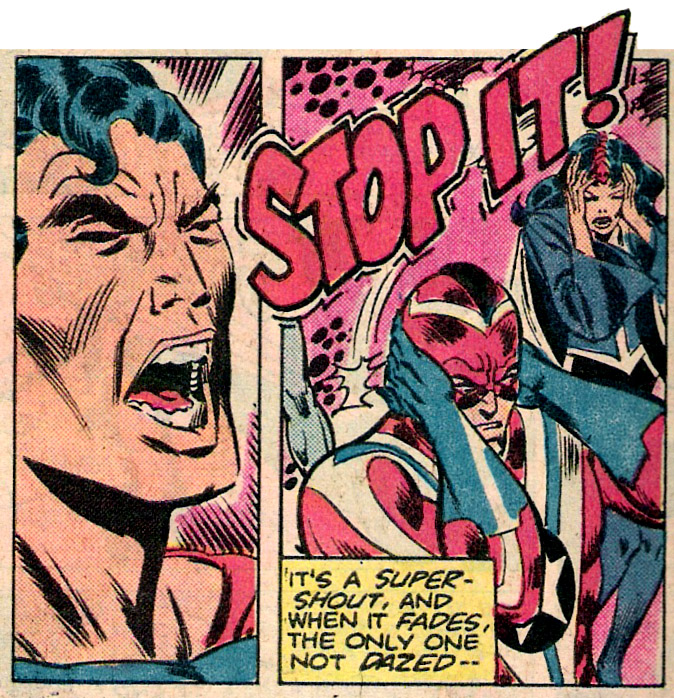 When Superman yells at you, you listen; or, you get spanked into the Antares system! The grown ups take the floor and explain about parallel worlds and time travel and Superman mentions an actor for president, though Don Heck's rendering looks more like Fred MacMurray than Ronald Reagan, to me... 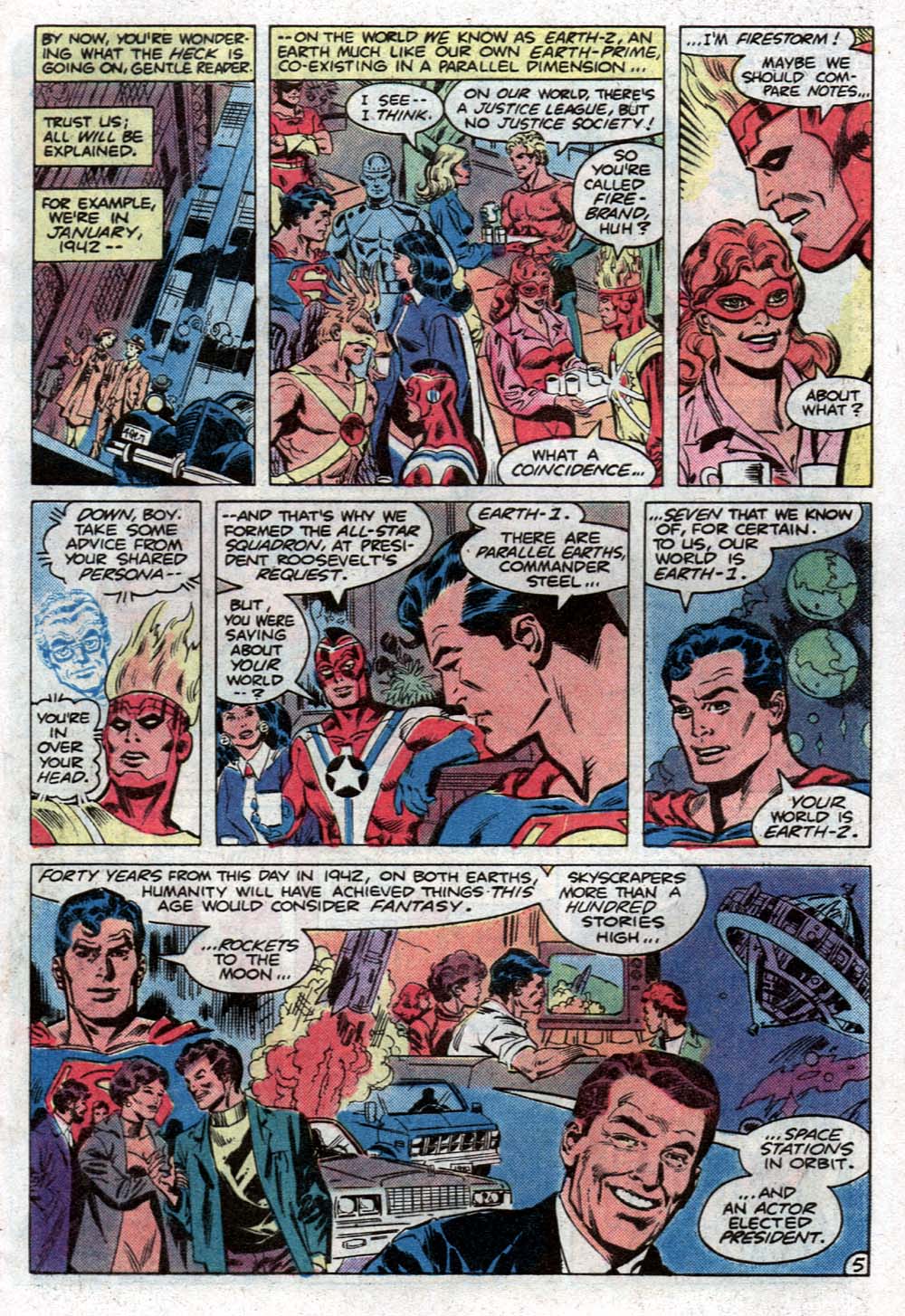 Superman fills the All-Stars in on what happened with the Crime Syndicate and what they found on Earth-2, in 1982. They are interrupted by a phone call from the White House and head there. Harry Hopkins shows them a VCR, sent by Per Degaton, who then speaks to them, except it is real time and he can hear them, despite a lack of microphones, cameras and satellite transmitters. That must be the higher end VCR. Mine only had freeze frame, timer, and auto-tracking features. Per tells Franklin that he has nuclear missiles, from the future and everyone is toast if they don't give in and make him ruler of the world. FDR feigns ignorance and Per tells him to talk to Gen. groves and Dr Oppenheimer and the scientists at the Manhattan Project (we'll get to that in the historical notes). He signs off, leaving us with bad renderings of Churchill and Hitler 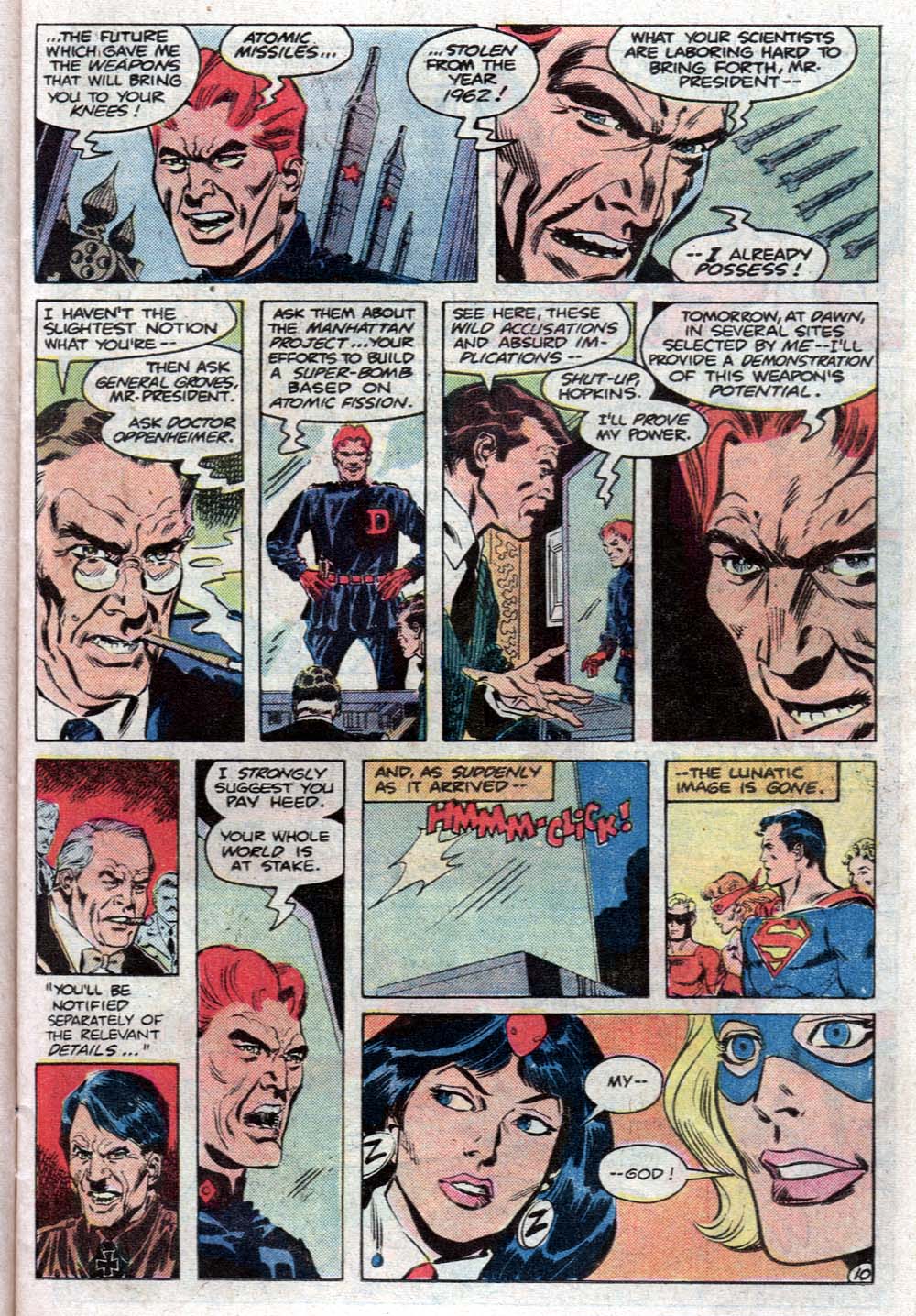 That's way more hair than Hitler ever had. Meanwhile, the JSA are on the devastated Earth Prime (where we live) and have to fight off a bunch of mutants (that's us), while gen. Urko and his soldiers attack the cathedral. Wait, that was Beneath the Planet of the Apes. Is this the one with Paul Williams? No that was Battle for the Planet of the Apes. Okay, well, these are pointy-eared, pink & magenta dudes with scarred faces and bug eyes. They fight them off and follow Green Lantern down a tunnel, where they find an old man who is blind, but was around when things got all mushroomy, and Dr Fate taps his memories. It seems that Kennedy called Khrushchev about missiles not being removed and he says they were stolen by flying men. Jack thinks Nikita has been at the vodka and presses the button (it's not a literal button, guys) and then it turns into Dr Strangelove. Back on Earth-2, 1942, the Navy is waiting for Per Degaton's demonstration, along with the JLA and the All-Stars. In comes a nuke, up goes a mushroom cloud, then out dumps a sphere with the JSA. So, everyone is finally together for the big meeting. Per cackles from his observation plane, in the sky. This issue also features a Masters of the Universe preview, from Curt Swan, which looks way cooler than the Filmation cartoons or the Mattel toys. The Sorceress looks like she belongs in GI Joe, though... 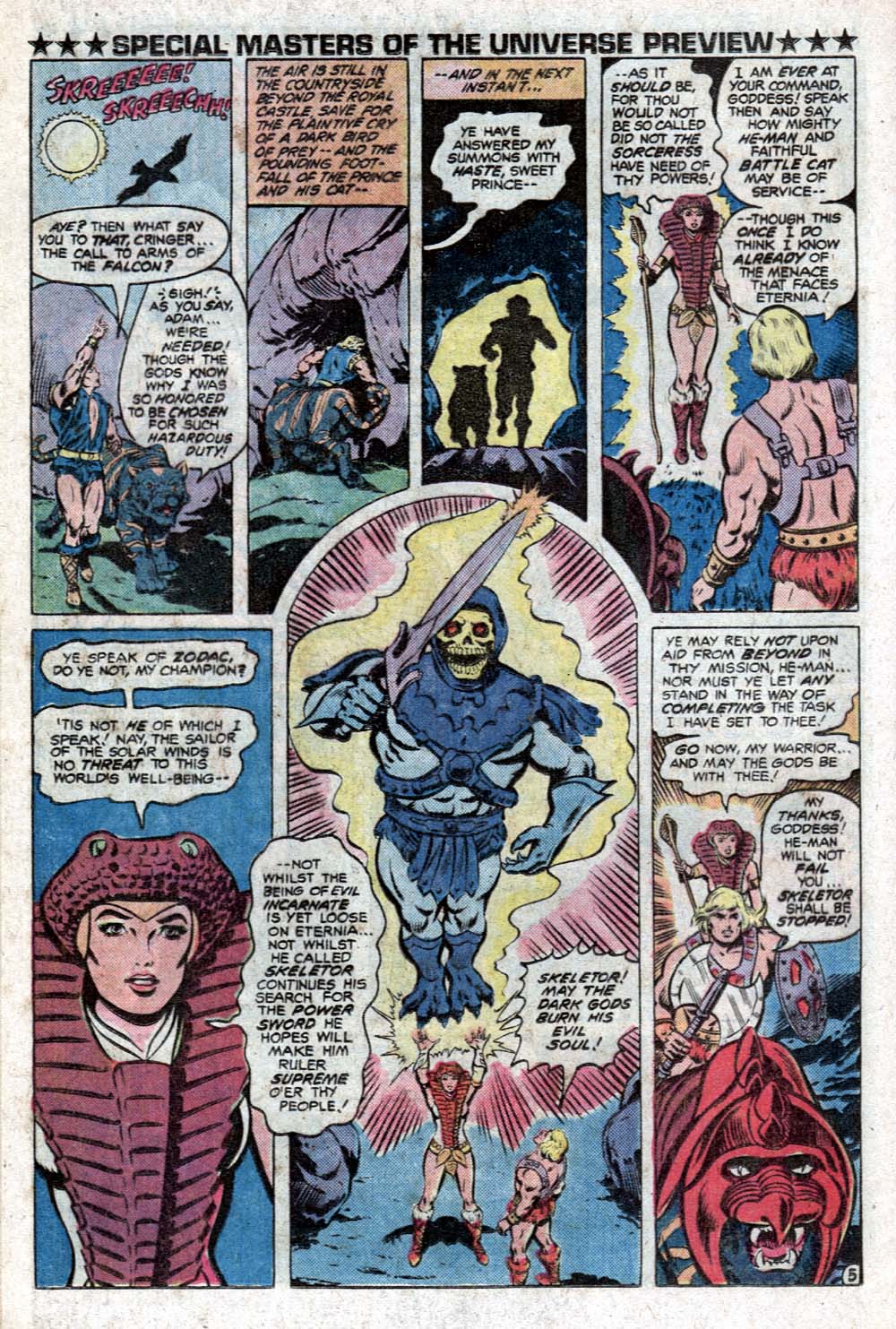 COBRA!!!!!!!!!!!!!! Thoughts: Well, let's see, some pointless fighting (Conway did that a lot; never shook off the Marvel cliche in his writing), future technology impressing the natives in the past, nuclear nightmares, POTA mutant rip-offs, and some mediocre likenesses (even Fala doesn't look like a Scottish Terrier). The story continues to be exciting, though Heck and Trapani are not a great combo and are the weak link in the visuals for this crossover. man, just imagine if Perez was still on the book and not just doing covers! This issue does serve to bring the players all together, after giving us both POVs; so, we should be heading along a more linear path now. We are smack dab in the middle of the story; so, expect business to pick up! Historical Notes: There is a major historical error in this issue. per Degaton shows his nukes and tells FDR to check with Gen Groves and Dr Oppenheimer, at the Manhattan Project. The Manhattan Project was established in August of 1942 and this is January. It was established as the Manhattan Engineering District, with the design of the bombs relegated to the Los Alamos Laboratory, which was headed by Dr Robert Oppenheimer, while the US Army Corps of Engineers, in Manhattan, dealt with the acquisition of uranium and other engineering functions, Leslie Groves was a colonel and deputy to Maj Gen Thomas M Robbins, head of the Army Corps of Engineers Construction Division. he was not promoted to brigadier general until September, 1942, when he was selected to replace Col John C Marshall as head of the Army wing of the project, after his failure to move things forward. groves was responsible for selecting and promoting the idea of Oppenheimer to head the bomb development and the pair of them selected the Los Alamos site. The movie Fat Man and Little Boy, starring Dwight Schultz and Paul newman, depicts them as having a contentious relationship; but, history does not bear this out. The film tries to put a military vs science debate on the project which was something that arose more in hindsight than during the project. Groves was hotly opposed on the choice of Oppenheimer, both as a Jew and for his involvement in left-wing organizations (including Communist groups) in the 30s. Oppenheimer was under FBI surveillance. Groves stuck by the man as the best choice, with the greatest breadth of knowledge relating to the project. Groves had a bad reputation within the Army, in pursuit of the Manhattan Project, where he bulldozed his way through protocol to get things done. In the post-War era, this was not looked upon kindly and a fitness evaluation with Eisenhower made it clear he would never head the Army Corps of Engineers and that he would never see another important post. The Manhattan District had turned over responsibility to the new Atomic Energy Commission and Groves decided to retire in 1948 and entered civilian life, where he was a VP for Sperry Rand, until his retirement at age 65. He died in 1970. Oppenheimer has been portrayed as horrified by the nuclear explosion results and there is truth in that; but, it has been greatly exaggerated and massaged to fit viewpoints in discussions. Oppenheimer greatly supported the quest for the bomb and showed triumph in the first successful detonation. he expressed sorrow that it wasn't ready in time to use against the Nazis; but, supported the bombing of Hiroshima. Where he started to break from this was in the use of the second bomb on Nagasaki, feeling that Hiroshima had been enough to prove what they could do. He sought and received a meeting with Truman that did not go well and expressed that he had "blood on my hands." He attempted to return to Caltech; but, didn't find teaching stimulating anymore. he moved into communal theoretical work; but ran into issues over security clearance, particularly in the mcCarthy years. his past with left-wing groups came back to haunt him and he was damned by some of his own colleagues, including Teller, though he did think that Oppenheimer's clearance should be maintained. Many in the scientific community rallied around Oppenheimer. The man, himself, spoke cooperatively of other political activities of colleagues and there is some feeling that had his clearance been renewed, then he would be remembered as a traitor who named names, rather than a martyr to McCarthyism. Oppenheimer was in favor of an international body to control and regulate nuclear developments for peaceful applications, with no national ownership. In later years, he promoted peaceful use of science. he was awarded the Enrico Fermi Award, in 1963. it was proposed by Kennedy, as a way of political rehabilitation; but, due to his assassination, Pres. Johnson actually made the award. Oppenheimer died in 1967, of throat cancer, after years of chain-smoking. Also in error is the two-way transmission of Per Degaton, with what is described as a VCR. A VCR, by definition, is a recording and playback device. It cannot independently receive tv transmissions; it must be plugged into a receiver. Usually, this was the tv antenna or coaxial cable, from the cable television system. That would allow the VCR to record programs and to display them through the television. It cannot transmit tv signals. That would require a camera to capture images and sound, then a transmitter to send them to a receiver. Since Per Degaton is using a communications satellite, he would need a satellite uplink to transmit the images to the satellite and back to his own receiver to view the happenings at the White House. No camera is seen and no satellite receiver or transmission antenna. The transmission of tv and radio signals was already known technology in 1942, as tv transmissions had been made earlier, including at the 1939 World's Fair. We saw this in the preview issue of All-Star Squadron. Radio and television were transmitted from towers, across a range dependent on the size of the tower and the power of the signal. Things like mountains and dense forests interfered with transmissions. Satellites were unknown, at this point. Arthur C Clarke is credited with theorizing the design for the first communications satellite, in 1945. In 1982, satellite communications were booming and growing, but were still way behind what we have today. Even in television, images broadcast by satellite were still a big thing. Gerry Conway is mixing a little too much real technology and comic book tech. He mentions the Dick Tracy 2-way wrist radio, as a comparison for the All-Stars of 1942; but, that was based on existing technology of the period, as the military was using "walkie talkie" portable radio transmitters, with limited range (as well as field radios, with much greater range). The problem with the Dick Tracy design was power and portability. Transmitters of the era required large batteries and antennas, which made a wrist design impractical, unless you had arms like Popeye. I take it Gerry Conway was reading comics in his science classes.
|
|
|
|
Post by codystarbuck on Mar 12, 2020 16:34:22 GMT -5
ps So, how does old Per Degaton pronounce his name? Is it "pur", like "miles per gallon;" or, is it "pair," like the Scandinavian pronunciation, as in Per Lundquist (an alias used by the Jackal in Frederick Forsyth's Day of the Jackal)?
Enquiring minds want to know!
Degaton is obvious......
...it's pronounced Throatwobbler Mangrove.
|
|
|
|
Post by Slam_Bradley on Mar 12, 2020 18:31:36 GMT -5
ps So, how does old Per Degaton pronounce his name? Is it "pur", like "miles per gallon;" or, is it "pair," like the Scandinavian pronunciation, as in Per Lundquist (an alias used by the Jackal in Frederick Forsyth's Day of the Jackal)? Enquiring minds want to know! Degaton is obvious...... ...it's pronounced Throatwobbler Mangrove. Per is pronounced Raymond Luxury-Yacht. |
|
|
|
Post by Prince Hal on Mar 12, 2020 19:11:27 GMT -5
Conway also blew it on Superman's pompous brag about skyscrapers over a hundred stories tall. The Empire State Building, all 102 stories of it, was built from 1929-1931. On both Earths-One and Two, I would assume, as well as on Earth-Prime. Sloppy work, Gerry. Fun review, codystarbuck ! PS: Hitler with that pompadour looks like Eric Roberts in a 1980s cable-ready B-movie.  |
|
|
|
Post by codystarbuck on Mar 12, 2020 20:46:15 GMT -5
Conway also blew it on Superman's pompous brag about skyscrapers over a hundred stories tall. The Empire State Building, all 102 stories of it, was built from 1929-1931. On both Earths-One and Two, I would assume, as well as on Earth-Prime. Sloppy work, Gerry. Fun review, codystarbuck ! PS: Hitler with that pompadour looks like Eric Roberts in a 1980s cable-ready B-movie.  Well, Roberts did play the Master, ho is pretty close to Hitler, in many respects. |
|
|
|
Post by codystarbuck on Mar 15, 2020 21:43:57 GMT -5
All-Star Squadron #15 Not sure how Robotman is on fire, in Earth orbit; but, hey, kids,,,,,comics! On the other hand, Joe Kubert has given Power Girl a Farrah Fawcett makeover (which was a bit dated, by 1982); and, hey, I just realized we fave to fin-accented superheroes! (Dr Fate's helmet kind of has a fin and kind of doesn't, depending on angle and artist). Obviously, for Starman, it acts as a rudder; but, I don't see how it helps Cdr Steel, unless he has it sharpened and uses it like a blade to slice through Nazis and/or their machinery. Creative Team: Roy Thomas-writer, Adrian Gonzalez-pencils, Jerry Ordway-inks, John Costanza-letters, Carl Gafford-colors, Len Wein-editor, Gerry Conway-plot consultant Synopsis: Per Degaton watches the results of his little demo (possibly through a large Radio Shack TRS-80). Per's flunkies are gettin' antsy; but, he shrugs it off. On the battleship below (said to be British) the JSA on the future is conversing with the JLA of the future (on a parallel world) and their All-Star colleagues, from the past, which is now the present. It's all timey-wimey stuff. A group of sailors seem to be admiring the lines of Huntress' costume, while Firestorm (who is partially a teenager) is looking down Power Girl's cleavage; but, because his eyes have no irises or pupils, she' can't tell. Everyone catches up and the JSA explain they followed the trail of Degaton's time machine; but, hit some kind of storm, got thrown into 1942 and ended up there. they catch up and everyone goes to tell FDR. Fala piddles on Robotman's leg. Degaton does a simulcast to the world leaders: make me the boos or turn everything over to the cockroaches. Superman, Robotman and Dr Fate track down Degaton's satellite, and smash it, when Robotman finds a lead box inside, which has kryptonite...  Ultraman turns up and bathes in its rays and Fate tries magic. It doesn't work and he gets KOed. robotman gets an arm ripped off and dumped back on course with Earth, along with the kryptonite and Supes. (that explains the fire; re-entry) Dr Fate recovers and messes with Ultraman long enough to distract him and let Supes punch him in the back of the head (Robotman nudged him away from the kryptonite) Superman knocks Ultraman out of orbit, Dr Fate surrounds it ina magical aura that will block Ultraman from re-entering, and Supes rescues Robotman before he turns into a ho plate. Starman, Liberty Belle and Aquaman trace Degato' s missiles (part of them) to an island in the south pacific and go after his mallard-steppers (like goosesteppers; but with less flair) They have to battle Superwoman who gets all lasso-y, and Liberty belle tries to stop her and they scramble for the Cosmic Rod and everything gets very Freudian....  Aquaman turns up with some wales and smashes into the hidden base; because ....um....I don't know, a Super Friends reference? I mean, whales hammering ships is one thing, smashing through tons of rock and coral and metall and stuff is another. Anyway, they capture Superwoman, who looks like she has been Marstoned, inside the Cosmic Rod's glowing field. In the Midwest, Johnny Quick, Huntress and Hawkman are hunting. they detect high levels of radiation and it is too early for the silos nearby to have anything other than grain. They run into Power Ring and the boys end up in green energy beefcake bondage and Huntress has to deal. Power Ring reveals the cliche of missiles in grain silos, 'cause it's funny....  Huntress' punch distracts PR, allowing the boys to get free and Hawkman lifts Johnny up to where he can reach the missile and disassemble it at speed. Degaton throws a fit and clutches his tiny hands, like future reprobates... 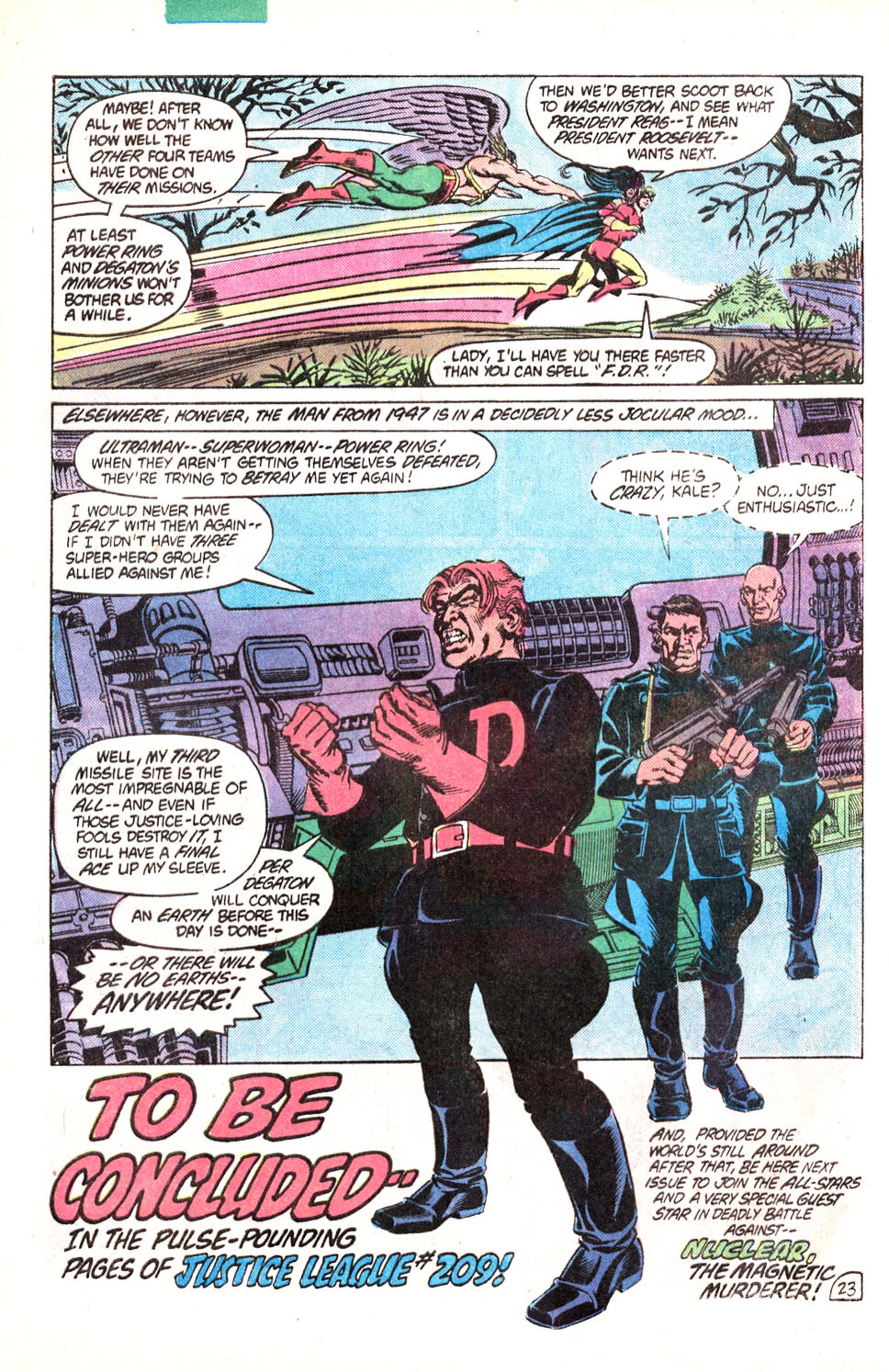 Thoughts: Thoughts: Roy employs the old split the teams off to deal with individual threats, before bringing them back together for the grand finales, which will be in the next JLA issue. 3 of the Crime Syndicate have been neutralized, which leaves Owlman and their Johnny Quick for next issue, then Degaton gets spanked by everyone, presumably. Left up in the air in all of this is what happened to Ultraa, Earth-Prime's first superhero? He got F-ed with a it; but, was back on track, before this issue; but, would not be seen again until after Crisis on Infinite Earths. Kind of feels like Roy is dragging things out a bit; but, I guess they did have to deal with Degaton's megatons.  Same to you, buddy!  (pre-emptive counter-response to joke feedback) Headed for the conclusion, which Conway gets to write, since this is a JLA/JSA crossover. Historical Notes:Not much. Two of Degaton's flunkies utter dialogue that was taken from King Kong. The other bit is that Liberty Belle mentions Gen James Doolittle's raid, which was in April of 1942, and this is January. In December of 1941, FDR addressed the Joint Chiefs and demanded a bombing attack on the Japanese home islands as soon as possible, to boost morale. Problem was, we didn't have any long range bombers that could reach them and carrier based aircraft couldn't get close enough or carry enough bombs to do much. Then Captain Francis S Low remarked to Adm King that he thought it might be possible to launch twin-engined Army bombers from a carrier, after observing aircraft at Chambers Field, at Naval Station Norfolk, where a carrier deck was painted on a runway, for practice landings. Lt Col James Doolittle was assigned to plan the raid. 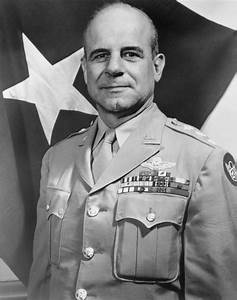 Doolittle had been a famous civilian aviator, test pilot and engineer. After considering several aircraft, he settled on the B-25 Mitchell, with added fuel storage. It had a wingspan that could be accommodated on a carrier flight deck, better take-off characteristics, ad good range. However, it had not flown in combat. The plan suggested that landing in Vladivostok could cut 600 NM off the flight; but, the USSR would not agree, as it had a non-aggression pact with Japan. Instead, landing sites in China were chosen. 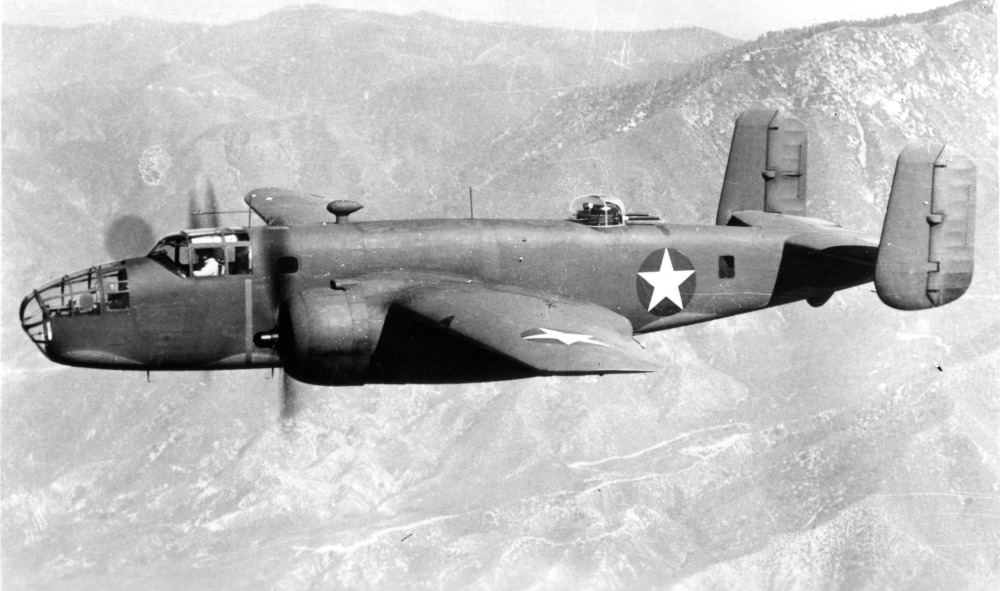 Two B-25s were test launched from the USS Hornet, in Feb 1942, proving it was feasible. The 17th Bombing Group was assigned the task, as they had the first B-25 squadrons. volunteers were selected and the crews trained in launching from the carrier, locating their targets, and evading the Japanese until they could land in China. The plan called for 20 planes and 24 were sent to be modified, with a gun turret removed, blast shields added, auxiliary tanks added, removal of the Norden bombsight, and a fake tail gun put on. The air crews took the planes to Florida in March and spent 3 weeks training. At the end of March, the bombers were flown to California and a test was done on the Hornet, to satisfy the Navy. 16 Bombers were loaded on the USS Hornet and the task group set sail for the south Pacific. the group consisted of the USS Hornet, Uss Enterprise (providing Combat Air Patrol for the group, since the Hornet was loaded down with the bombers), the cruisers Salt Lake City, Northampton and Vincennes, the light cruise Nashville, 8 destroyers and two fleet oilers (fuel ships which can refuel other vessels while underway). The oilers fueled the group and then departed with destroyer escort and the raiding force steamed to their launch point. they were spotted by the Japanese pickett boat Nitto Maru, 650 NM from Japan. It radioed its superiors, but the vessel was attacked by the Nashville. The skipper committed suicide, but most of the crew were rescued by the Nashville (you always attempted to rescue the crew of sinking ships, as it might be you some day). Doolittle decided to launch immediately, 170 NM beyond their intended launch point. All 16 aurcraft safely launched and headed for primary and secondary targets. The aircraft flew at wavetops to avoid detection; then, at Noon, Tokyo time, they climbed to 1500 feet and launched bombing runs. Their targets were in Tokyo, Yokohama, Nagoya, Kobe and Osaka. They encountered some ground fire and enemy fighters; but, only one [plane sustained any damage and continued on its course. After dropping their loads, 15 headed southwest, over the East China Sea; and, the 16th, low on fuel, headed for Vladivostok. The aircraft were low on fuel, night was moving in and conditions deteriorating. However, a tail wind had increased aircraft speed and all made the China coast. Two crews (10 men) went unaccounted for until after the war, when it was revealed they had been captured by the Japanese, while 2 men had drowned when their bomber ditched in the sea. the other 8 were executed by firing squad. The 16th bomber landed in Vladivostok and the crew was arrested and interned, their plane confiscated. They eventually "escaped", which was arranged by the NKVD, allowing them to get to Iran, where they were repatriated. the ruse was done to cover the Soviets, since they were not technically at war with Japan. The raid was announced to the general public, with FDR remarking that the raiders had flown "...from our bases in Shangri-La" (Roosevelt was a great admirer of James Hilton's novel, Lost Horizon, which introduced the fabled city of Shangri-La). The mission actually resulted in little real damage; but, it was a massive morale booster for the home front, as it was one of the first offensive missions and was considered a logistical success. Soon, the Makin Island Raid would add to this, leading into the US landings at Guadalcanal. Doolittle expected to face court martial, due to the minor damage caused and the loss of all aircraft (in effect, since they ditched). however, the boost in morale made them heroes. Doolittle was awarded the Medal of Honor and promoted from Lt Col to Brig Gen, completely skipping Colonel. All 80 raiders were awarded the Distinguished Flying Cross and the dead and wounded were also awarded the Purple Heart. Two men were awarded the Silver Star for aiding wounded crewmen. The Raiders held an annual reunion, beginning after the war. The last Doolittle Raider, Lt Col Richard E Cole, passed away in January of 2019. The Raid was dramatized in the Hollywood motion picture, 30 Seconds Over Tokyo, starring Van Johnson, with Spencer Tracy as James Doolittle. The film re-enacts the carrier launch and bombing run, then the ditching in China and evasion of Japanese troops, with the aid of Chinese civilians, who suffered major reprisals. The footage was later re-used for the opening sequence to the movie Midway, which dramatized the Japanese response, including launching the planning of a dual attack on Midway Island and the Aleutian Islands, off Alaska. Here is newsreel footage of the raid, released later (with some way off base speculation about damage to the Japanese, as well as repeated use of the terms "Japs") Some years later, an experiment was conducted with the C-30 Hercules cargo plane, testing it's ability to land and launch from a carrier (the USS Forrestfire....er...Forrestal)...
|
|
|
|
Post by codystarbuck on Mar 19, 2020 13:37:57 GMT -5
Justice League of America #209 I won't go into how Degaton broke the image behind him; but, it involves chili night. Creative Team: Gerry Conway-writer, Don Heck-artist, Ben Oda-letters, Carl Gafford-colors, Len Wein-editor, Roy Thomas-plot consultant Don Heck inks himself. Synopsis: The combined JLA/JSA/All-Stars team returns to the White House to report into FDR. They relate what happened with the CSA members and Hawkman repairs Robotman's arm, while Ben Kenobi tells him about his father and gives him his lightsaber. 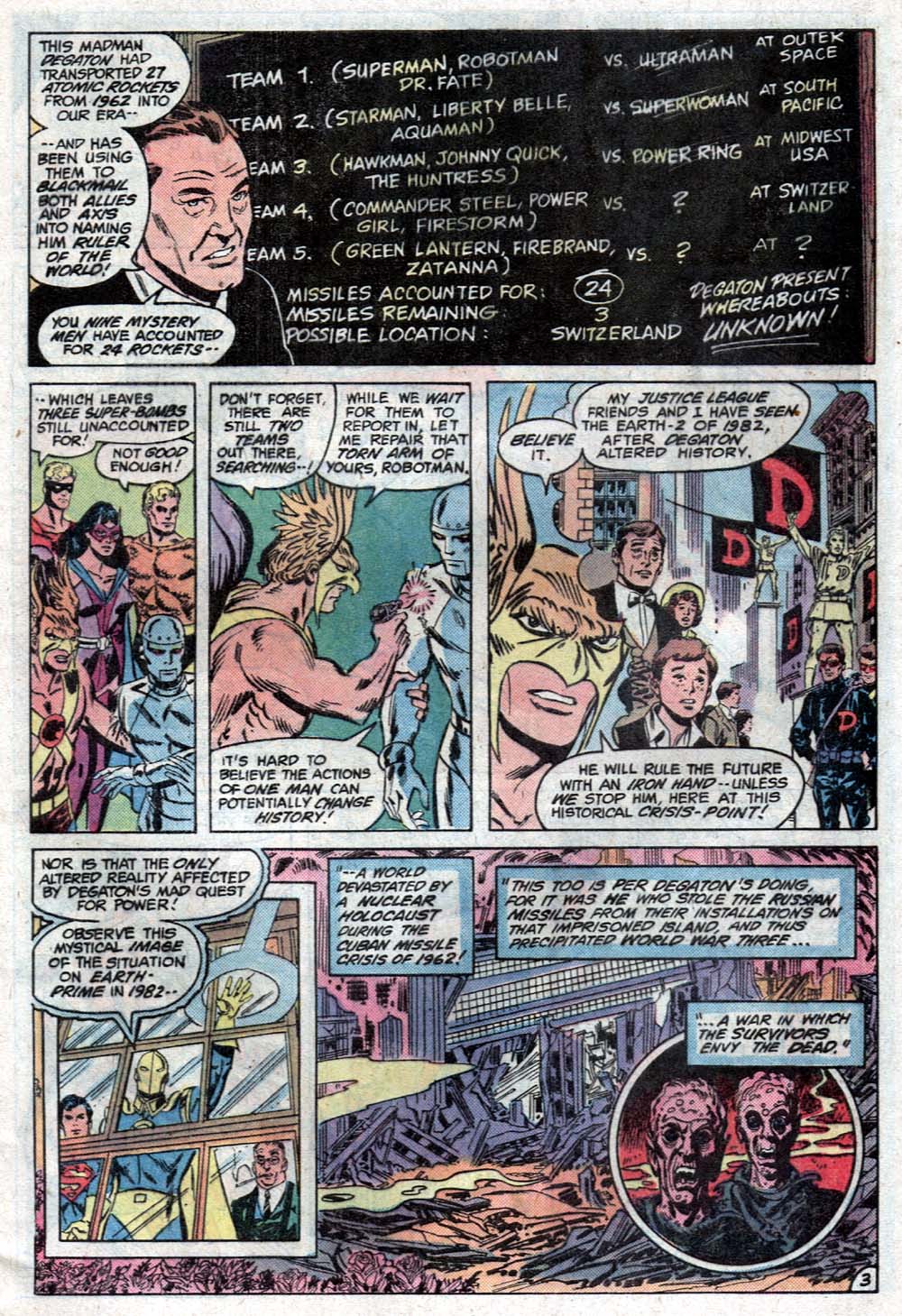 Hawkman relates the future of Earth-Prime, in 1982, with the mutants, as they go in search of Johnny Quick (Earth-3 version) and Owlman. FDR ponders the cost in lives of the Manhattan Project, which doesn't exist yet. Meanwhile, Firestorm, Power Girl and Cdr Steel land in geneva, Switzerland, looking for missiles. A burgomeister (Meisterburger?), in stereotypical dress, comes out to tell them to get out of Switzerland (unless they want to make a deposit) and they are attacked by Degaton's goons. Firestorm takes care of them, while Power Girl searches for the missiles and runs into Johnny Quick. She gets knocked into ein haus, whose frau is not happy, und den Firestorm creates a vise and squeezes the air out of Johnny and he passes out. However, the missiles launch and the three try to disable them. They succeed and the world is safe for Nazi gold, stolen from Jews. Green Lantern, Firebrand and Zatanna visit Prof Zee, to try to stop Degaton from using his time machine, in the future. GL's ring assembles the new machine (it has only been a theaory and some components gathered) and they go to the future, in 1962, to stop the CSA. In Washington, Superman leads the team to the building site of the Pentagon and they locate Degaton's missiles. 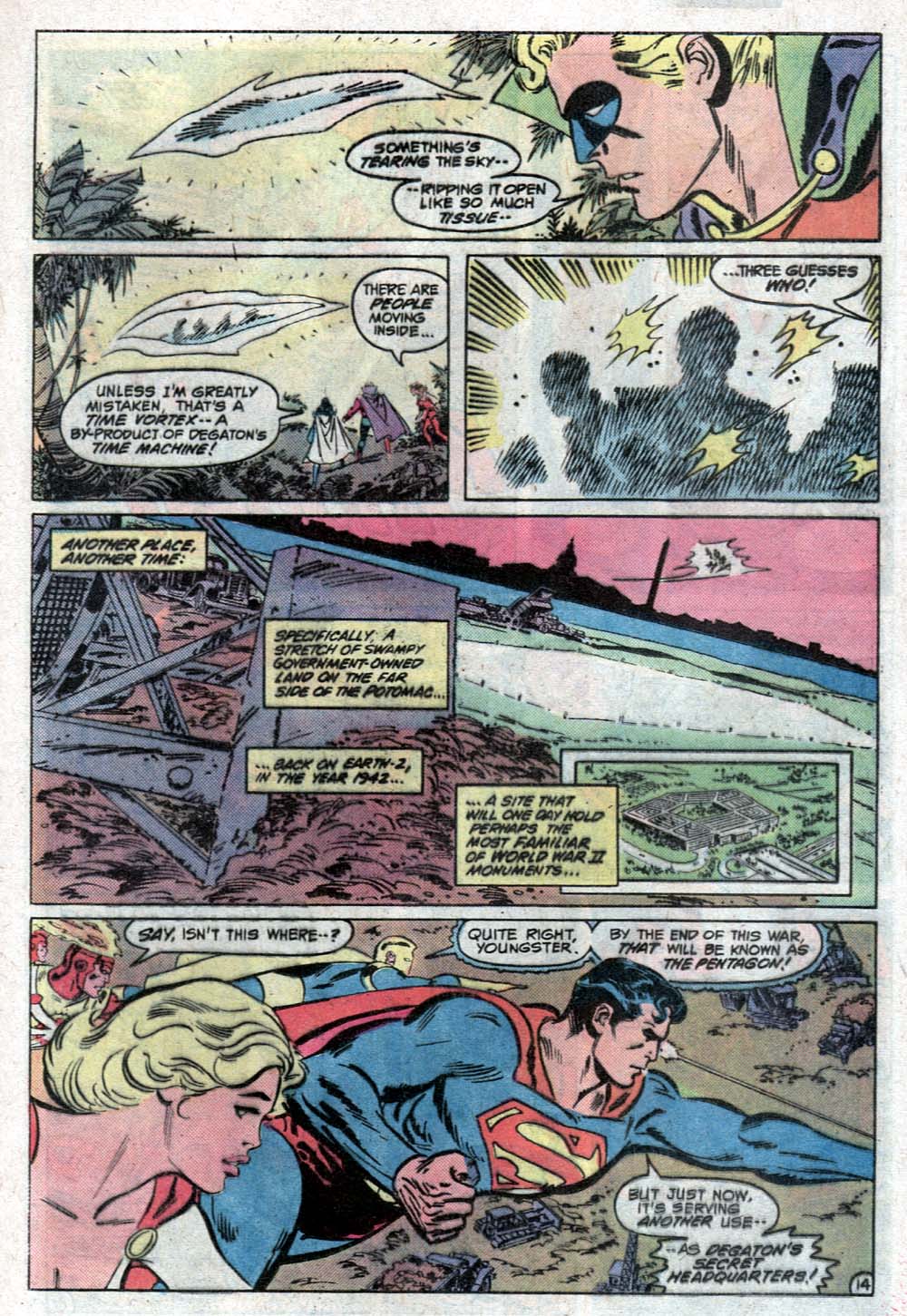 His goons are routed and Owlman tries to slip away, only to get a Bat-Kick, from Huntress... 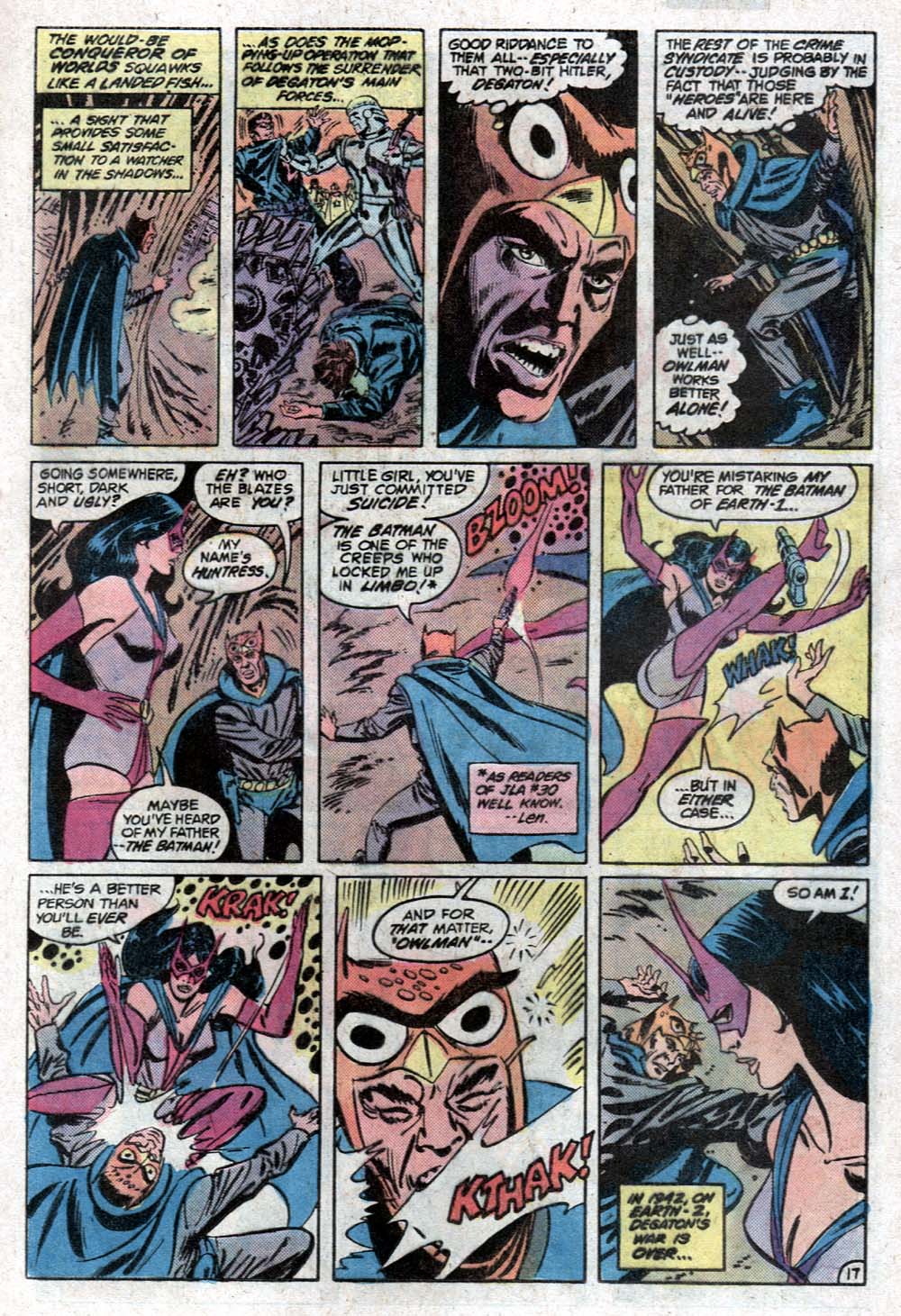 Yvonne Craig would be proud! She then chops him into hamburger and he is out for the count. In the future, GL's team stop the CSA and Zatanna nabs Degaton. The time paradox rights itself (without Sam Beckett) and everyone reverts back to their previous, time, world and situation... 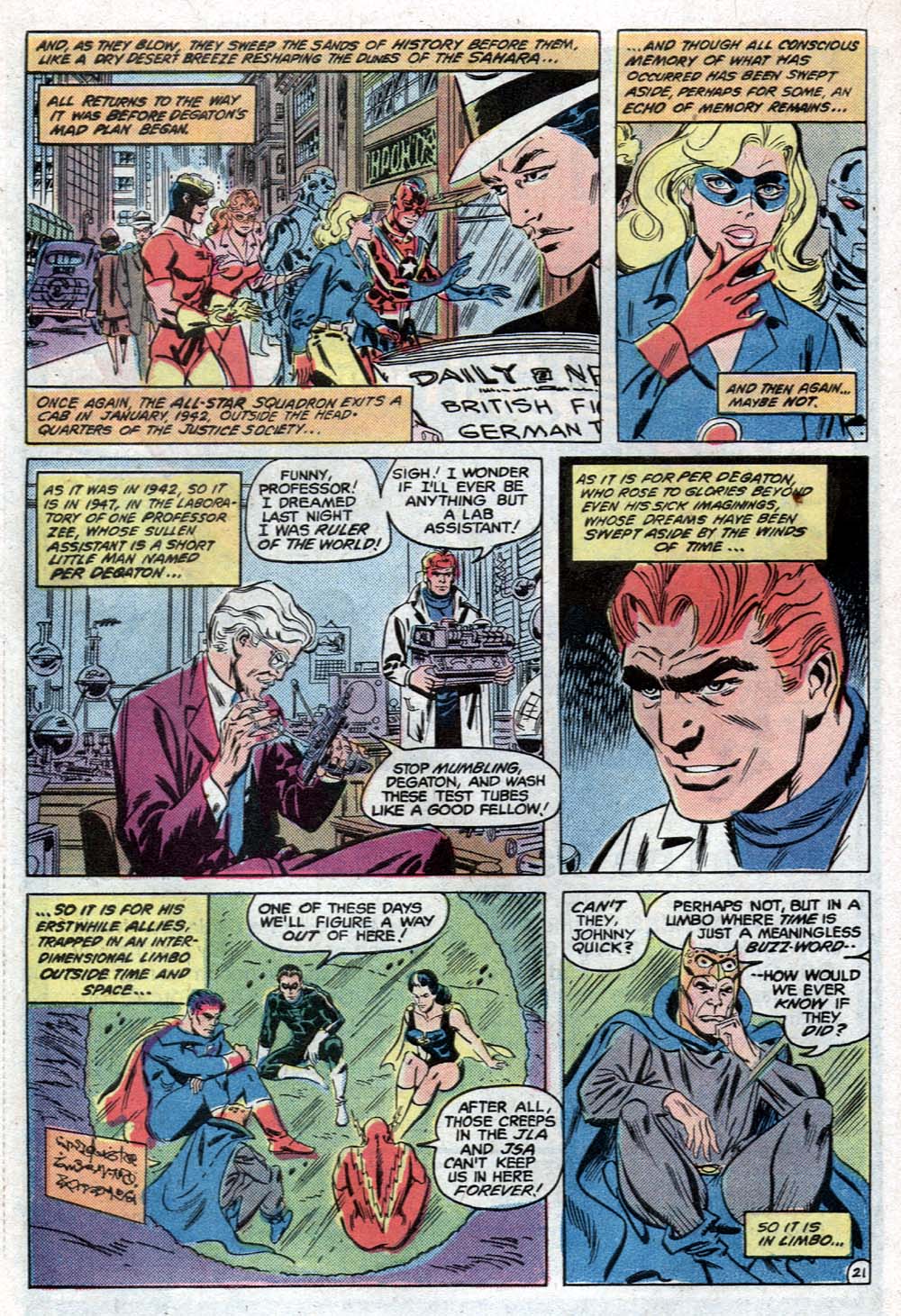 The JSA cross over to the JLA satellite and they have a party and Firestorm macs on Power Girl and she is receptive. That's not the Power Girl I remember. Isn't he still a minor? Thoughts: The ending is a bit easy in resolution; but, the whole of this makes it work, when read together. The fights with the CSA are a bit repetitive and the reboot option is a bit pat. Still, this is one of the better JLA/JSA crossovers, though a few steps behind the previous one, with the Secret Society of Super-Villains. Granted, that had George Perez on art. As things go, the All-Stars are used fairly well and it involves quite a bit of history, which I always liked. Historical Notes: Nothing particular. The unfinished Pentagon is depicted. Ground was broken in September 11, 1941 and dedication was in January 15, 1943. Because of steel restrictions, it was primarily constructed in reinforced concrete. It was built a wing at a time, with the completed sections occupied immediately, while construction switched to the next wing. It was built under Virginia segregation laws, with separate restrooms and water faucets; but, upon visiting the site and seeing signs that said "Whites Only," FDR ordered signs removed and it became the only building in Virginia where races were allowed to mix freely. 60 years after construction began, American Airlines Flight 77 was deliberately crashed into the structure, by terrorists, who hijacked the plane, during the 9/11 attacks. 189 people were killed: 125 people in the building, 59 passengers and crew of the plane and 5 terrorists. Previously, in 1972, The Weather Underground detonated a bomb in a 4th floor restroom, in retaliation for the bombing of Hanoi.
|
|
|
|
Post by Prince Hal on Mar 19, 2020 13:55:08 GMT -5
codystarbuck, I had fallen behind on my reading here and just caught up. Always enjoyable and I always learn something new. (The whole Vladivostok to Iran escape would make a great book, I'll bet!) I read Ted Lawson's book Thirty Seconds over Tokyo in the Landmark edition when I was a kid and loved it. Watched the movie back then, too, and enjoyed that. Besides that and the last third or so of Pearl Harbor  , are there any other film adaptations you are aware of? And is there a solid, go-to book about the raid and/or Doolittle?
|
|
|
|
Post by codystarbuck on Mar 19, 2020 16:40:18 GMT -5
Well, Midway (the good one, from 1976) starts out reusing the footage of the carrier launch, from 30 Seconds over Tokyo, then starts up in Japan, after the bombing raid, as Adm Yamamoto is notified by his aid and summoned for a strategy conference, where they will lay out their plan for the attack on Midway. The mini-series War an Remembrance (based on the Herman Wouk novel) features elements. The Cary Grant movie, Destination: Tokyo features a submarine raid, inspired by the Doolittle Raid. There are numerous documentaries, including a segment in the excellent The World at War and Doolittle's Raiders; a Final Toast, which examines the raid and the last public reunion of the surviving crews. It is also featured in the Battle of Midway episode of the documentary series, Battlefield, which is on Youtube. It is covered as part of the prelude to Midway. As for books, there have been many. Gen Doolittle wrote his memoirs, titled I Could Never Be So Lucky Again...  This tells his personal story, with the Raid being the central point. Craig Nelson's The First heroes features interviews with the surviving raiders...  The Doolittle Raid, by Carroll Glines is from the official historian for the Raiders. 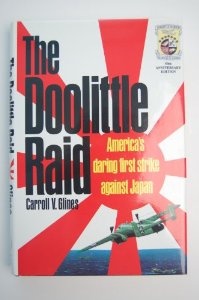 Stan Cohen's 1983, Destination Tokyo, A Pictorial History of Doolittle's Tokyo Raid has extensive photo references of the planning and the mission and is praised by the Raider's association. Also worth noting is the Makin Island Raid, carried out by the Second Marine Raiding Battalion, aka "Carlson's Raiders." The Battalion had been raised, under the urging of Lt Col Evans Carlson, who had served as an observer in China, where he was greatly impressed by Mao's People's Army, and their ability to march and fight, with minimal provisions, but tremendous esprit de corps. He founded the Marine raiders under those principles, with political backing from James Roosevelt, FDR's nephew, who was a Marine Reservist. Carlson and his men mostly eschewed traditional Marine organizational structure, building a squad around 10 men, with 3 3-man fire teams (armed by a BAR support machine gun, an M-1 rifle and a Thompson submachine gun). The men trained and lived together, with officers taught that they were there to serve th men, not vice versa. Their motto was "gung ho," adapted from the Chinese phrase gong he, meaning the spirit of cooperation. The Raiders were selected to carry out a symbolic raid on a Japanese base, with Makin Island, in the Marshalls, picked for the target. The island had a seaplane base and a compliment of about 71 men. The Raiders were assembled out of two companies and carried on two submarines to a launch point. The landed in rubber boats, but their outboard motors mostly failed and they were forced to row their way in. The pplan called for two landing sites; but, difficulties in landing led to the entire force landing at one site, which proved to be to their advantage. They encountered sniper and machine gun fire , which slowed their advance and wiped out two banzai charges, killing most of the defending forces. the force had split into two, with Lt Peatross leading the second team, which outflanked the defenders and wiped out the remainder of the defenders. They destroyed enemy radios and made for their rendezvous. two seaplanes, with reinforcements for the Japanese came in and met heavy machine gun fire, with one crashing and the other bursting into flames. At the planned time, the Raiders tried to make it to the submarine extraction; but, heavy surf made it extremely difficult. Only 7 boats made it. A second attempt was made in the morning, with several boatloads making it; but, 72 men still on the island. the sub sent a boat, stretching a rope to help pull Raider boats to the sub, but was attacked from the air and the subs were forced to crash dive. they lay on the bottom until the oast was clear, then resurfaced and extracted the remaining Raiders. Casualties were 18 KIA and 12 MIA. 1 of the 12 was later identified to have been buried with the dead, meaning the KIA count had been wrong. 9 of the MIAs had ben inadvertently left behind in the nighttime withdrawal and were captured and executed by the Japanese. The fate of the other two is unknown. The raid served little strategic purpose and revealed several logistics problems with the Raider concept and the idea of commando raids on Japanese positions was largely abandoned. However, carlson vindicated the Raider training and formations during the fighting on Guadalcanal, where they inflicted heavy casualties on the Japanese, during jungle penetration raids. The raid was used for propaganda purposes and the Raiders became heroes, which helped protect Carlson from political enemies in the Marine Corps. Guadalcanal helped to further protect him, though he suffered injuries and malaria during the fighting, where he earned his 3rd navy cross (he was awarded his second for the Makin Raid.). Carlson handed over command to a more orthodox officer and the Raiders were diverted from philosophy and original mission. Carlson recovered from his injuries and served as an observer at Tarawa, where he was cited for volunteering to deliver vital messages to division headquarters, through heavy enemy fire. At Saipan, he was wounded, while rescuing a wounded radio operator, earning a second Purple Heart. "Gung Ho" was the Raider creed, but it became a term of derision within the service, for over-enthusiastic aggression, rather than a motto of cooperative spirit to achieve the impossible. Carlson served as the technical advisor on the wartime film, Gung Ho, starring Randolph Scott, about the raid. Young Robert Mitchum plays one of the raiders. Several books have been written about the raid and Carlson's Raiders, with Lt Peatros writing a memoir, Bless "Em All: The Raider Marines of World War II. The Army developed a similar concept, The Alamo Scouts, founded within the Sixth Army. They operated behind the lines and conducted raids in the New Guinea campaign, as well as other reconnaissance missions; but, are best remembered for the Cabanatuan Raid, in the Philippines, where they rescued POWs from the Cabanatuan Prison Camp, who were slated to be executed. The story of that raid was best told in Hampton Sides book, Ghost Soldiers. Similarly, the early British commando missions were more of an exercise in morale than strategic attack, though they did eventually produce excellent intelligence material, created confusion witin Occupied Europe that drew defenses elsewhere, and help test plans for the eventual landings at Normandy. The first real strike back at the Japanese was the Battle of Midway, where the US set a trap for the Japanese fleet and sank their carriers, with the loss of the USS Yorktown. That ended the Japanese ability to launch offensive operations and they went into a defensive posture. The US then began it's long campaign to retake the Pacific, starting at Guadalcanal, in the Solomon Islands. This island was necessary to take to neutralize a Japanese airfield and provide a base from which to launch further landings, to establish more bases. As islands were taken, they immediately went to work creating airfields and bases from which to launch strikes on Japanese bases, in support of further landings. Some islands were captured, while others were isolated and cut off from resupply. The large Japanese base at Rabaul was eventually ringed in and cut off; but, not invaded. It was subjected to continuous attacks until the end of the war and only finally pacified after the Japanese surrender, in 1945. US Strategy involved the halting of the Japanese advance on New Guinea, which put it in range of striking and/or cutting off Australia as a base for the Allies. Thus, the Battle of Coral Sea helped block the Japanese attacks on New Guinea. The landings on Guadalcanal neutralized the Japanese airfield, to take it out of the New Guinea equation. then, the Allies began moving north, into the Gilbert and Marshall Islands, the Marianas Islands and westward, into the Philippines) then on to Okinawa (340 miles to the south west of Kyushu), which would put Japan in range of B-29 Strategic Bombers and provide a base for an invasion of the Japanese home island of Kyushu, the Southern-most. One of the things I meant to comment on was Gerry and Roy's retroactive placement of doubt about the human cost of developing the Atomic Bomb. This is a long historical debate, in hindsight, but was not one being waged, in a major manner, at the time. Development took time and the conventional amphibious campaign was necessary to push the Japanese back, with the costs high in casualties. The Japanese samurai tradition did not include surrender and every piece of ground gained was paid for in blood and bodies. As Sam Glanzman documents in A Sailor's Story, the Japanese often committed suicide, rather than surrender, when they were out of ammo or other supplies. Even civilians killed themselves, believing propaganda that they would be tortured and murdered by the Allies. Fighting became more and more brutal as the campaign progressed, particularly in the Marianas, where the names of Kwajalein, Pelieu, Tarawa, Saipan and Iwo Jima are considered sacred, to the US Marines. These were lands that they paid for with their blood and the bodies of friends and comrades. Each one became more hallowed than the last and Okinawa was the worst. Landings began on April 1 and the full pacification of the island wasn't achieved until late June. The American suffered over 12, 000 dead and another 37, 000 wounded. The Japanese suffered 110,000 dead and 7400 taken prisoner. 94% of the population of Japanese soldiers and civilians died in the fighting. Kamikaze attacks sank 36 ships and damaged over 300 others. This was a prelude for what an invasion of the home islands would be like. The difference would e that the Japanese would be defending their homes, not their bases or conquests. With the war over in Europe, the Army was preparing to send large segments of its forces for the planned invasion. The Atomic Bomb attacks on Hiroshima and Nagasaki led to somewhere between 140,000 and 240,000 deaths (either directly or indirectly). The firebombing of Tokyo led to over 100,000 deaths. Aerial mining of Japanese waterways cut them off. Had the the Japanese not surrendered, Hiroshima and Nagasaki would likely have represented the lower end of casualties from continued attacks on Japan. Japan's navy was largely neutralized at the Battle of Leyte Gulf; but, they could still produce planes to carry out kamikaze attacks and inflict casualties in greater numbers than the lone pilot. Planning expected continuous kamikaze attacks on ships, intense fighting in all sectors, and probable years of fighting to subdue Japan, if ever. In the end, the Atomic Bomb put an end to that potential future. The question then becomes was it worth it? At the time, most would say, yes, it was. It erased the need for an invasion, preventing further deaths on both sides, though conditions in Japan would lead to further civilian deaths. In hindsight, given the horrific way in which the people of Hiroshima and Nagasaki died, we have to question if anyone has the right to use such weapons against fellow human beings or any living creature. That question has to take into account subsequent history, more than what was at stake then. Given the horrors of the fighting at Iwo Jima and Okinawa, imagine that played out across Kyushu, then Shikoku and onto Honshu. Honshu was the most densely populated and the seat of industry. Okinawa was tiny by comparison to just Shikoku, let alone Kyushu. In the end, the bombings of Hiroshima and Nagasaki probably saved more future lives than they took. They also served to teach humanity how dangerous such a weapon was and led many to reconsider whether there should be moral limits to science and technology that has given pause to such weapons being used since. It is still a razor's edge, with no really satisfying answer. War is nothing but death and destruction and the debate really should be whether one life is justified, long before we debate about millions, from the moral perspective |
|
|
|
Post by Prince Hal on Mar 20, 2020 10:17:36 GMT -5
Thanks, codystarbuck , for the info on books about Doolittle. And a history of the Pacific War as a bonus! I wonder if you've read or read about a book that came out several months ago that focused on the contributions of the Army in the Pacific, Fire and Fortitude: The US Army in the Pacific War, 1941-1943, by John C. McManus.  His purpose was to correct the notion that it was the Marines who "won" the war in the Pacific. He never denigrated their contribution, of course, but said that he wanted to give the Army its fair share of the credit for what they did. I found it well worth reading, even though I had not enjoyed one of his earlier books, The Dead and Those About to Die: D-Day: The Big Red One at Omaha Beach. I had read good things about it, but it never grabbed me as this one did. No matter if you have a dogface in this fight, McManus' account of the war from the GI's level is as vivid and excruciating as you might imagine, particularly the hideous campaign in New Guinea. On the lighter side, he brought to often ribald life the conflict between the Aussies and the Americans when the latter were stationed in Australia and/or there on leave. He's no fan of MacArthur, either, but does highlight the heroism of a few career officers who had to labor in the shadow of their vainglorious commander. It's long and detailed, but he does a good job of explaining strategy and revealing the power struggles in the US command, naval, air and ground. BTW, you mention Hampton Sides' Ghost Soldiers, which was superb. I have read several of his books, and have enjoyed each one, most recently his book on the Battle of the Chosin, On Desperate Ground. He explains strategy and tactics clearly and centers his story around individuals as a way to tell an enormous story in human terms. Loved your movie choices, too. Destination: Tokyo is a subful of wonderful cliches, but a great story. The first Midway I have not seen stem to stern in a long time, but it walked the line between history and soap opera about as well as it could have Tora! Tora! Tora! was less soap operatic and more historical in tone. Both are far better than the Michael Bay video games that have come out since. I love what you're doing with this thread, cody. I know how much work it takes, labor of love or not. Thanks! |
|
|
|
Post by codystarbuck on Mar 20, 2020 12:18:51 GMT -5
Yeah, it is less remembered that the Army took part in many of the island landings, though they were most heavily involved in the New Guinea and Philippines campaigns, compared to their presence in some of the other landings. The Army Air Force had a major presence in the campaign to establish air superiority in the Pacific, as they operated off of new airfields established and launched B-25 and B-26 bombing strikes, attacks on airfields and attacks on Japanese shipping, to cut off supplies to Japanese bases. Richard Bong, the most decorated air ace of the US, during the war, shot down 40 planes, while flying a P-38 lightning, in the USAAF.
|
|
|
|
Post by codystarbuck on Mar 22, 2020 14:23:52 GMT -5
You know, I plum forgot a piece of history related to this storyline and the first few issues. In 1980, the USS nimitz, under the command of Capt. Matthew Yelland, set sail for fleet exercises, in the Pacific. 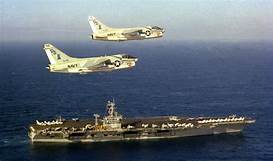 The ship had recently been deployed to the Indian Ocean, in response to the US Embassy Siege, in Tehran, Iran. It had docked in Pearl harbor and picked up a civilian observer, from the company that built the Nimitz, the largest warship in the world (at the time). While under routine sailing, the ship encountered strange weather, with darkening clouds filling the sky, sudden lightening and tremendous air pressure, which caused the crew to sustain tremendous physical discomfort. The phenomena soon passed and the crew recovered. However, it had lost radio contact with Pearl Harbor and its escorts, who were not on radar. Capt. Yelland called the ship to General Quarters and launched a reconnaissance plane to scout the area. The plane returned with shocking photographs. Meanwhile, the ship receives a surface contact and launches a combat air patrol to investigate. The planes are vectored to the contact and are amazed to witness an A6M "Zero" fighter plane strafe a civilian yacht. The aircraft report to the Nimitz and are ordered to drive off the Zeroes, without firing, if possible. They swoop in and use their jetwash to drive the Japanese planes away from the stricken yacht. However, the planes head on a course for the Nimitz and the F-14 pilots are cleared to shoot down the aggressor aircraft. The fighters shoot down the prop planes and one of the pilots is recovered. meanwhile, the passengers of the yacht are rescued and identified as Sen. Samuel Chapman and his secretary, Laurel Scott. he is on the Senate Appropriations Committee and has never seen a carrier like that one. The CAG (Commander, Air Group), LCDR Richard Owens is an amateur historian and recognizes the senator, from the 1940s. Meanwhile, the reconnaissance photos of Pearl Harbor reveal battleships moored in the harbor and the complete absence of the USS Arizona Memorial. Owens matches the photo with historical books he has about the Pearl Harbor attack and verifies that those are the ships present at the attack and confirms the date as December 6, 1941. They reach the conclusion, no matter how far-fetched, that the Nimitz has passed through time. After much debate, Capt. yelland decides that they took an oath to protect and defend, without regard to history. They will carry out their mission wherever they are. The ship and aircrews prepare to launch airstrikes to intercept the Japanese fleet, headed for Pearl Harbor. As they prepare to launch, the ship again encounters the strange weather phenomena and reawakens back in 1980, with radio contact re-established. they suffer three casualties: Sen Chapman, Laurel Scott, and LCDR Owens. The US Navy suppressed the encounter, classifying it top secret, though rumors of what happened spread quickly through the fleet. Eventually, some gun camera and shipboard CCTV of the event emerged. The US Navy dismissed the footage as a hoax, claiming it was produced by a low budget film company, which specialized in goofy horror-comedies. they even created a few fake films from this group, with unlikely names like The Toxic Avenger and Surf Nazis Must Die. However, like the similar Philadelphia Experiment, the truth was not easy to suppress. Here's a photo, taken by a crewmember, when the storm rolled in...  Gun camera footage of the Zero, beginning it's strafing run on Sen Chapman's yacht...  The civilian observer was later identified as Warren Lasky, of Tideman Industries....  A photo of Sen Chapman's secretary,Laurel Scott...  Here is gun camera footage that was leaked out.... Capt. Yelland died this past February. LCDR Owens was reported "missing" in a "training accident." History records that Sen. Chapman and his yacht disappeared in the Pacific, in a storm, though no such storm was witnessed near Hawaii. Warren Lasky went on to a career in Washington and spent considerable time at the White House. In 1982, when the incident was still fresh in the minds of people, Roy Thomas, who had relocated to California, heard the rumors from a friend who had recently left the Navy. He took the idea and used it for both the time travel aspect of Per egaton's attacks and the relation to te attack on Pearl Harbor and revisited it for this, relating it to the Cuban Missile Crisis. ironically, Warren Lasky's father was a government advisor and close friend of robert Kennedy, during the Crisis. In fact, some people said the young Warren Laskey looked much like Robert Kennedy, in 1962. |
|